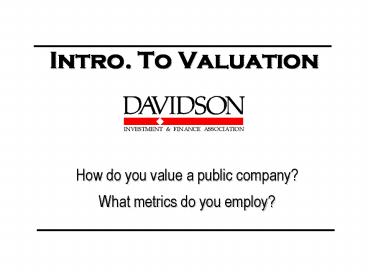Intro' To Valuation PowerPoint PPT Presentation
1 / 11
Title: Intro' To Valuation
1
Intro. To Valuation
- How do you value a public company?
- What metrics do you employ?
2
Table of Contents
- I. Fundamental Analysis
- II. Technical Analysis
- III. Value Analysis
3
Fundamental Analysis
- Understand the business model
- 10K, 10Q
- Letter to Investors/Prospectus
- Analyst reports
- Press releases
- What are the core earnings drivers?
- Review historical performance and earnings
estimates
4
Fundamental Analysis
- Graham Dodd (vs. Peter Lynch)
- Investors should buy stocks with undervalued
assets and that eventually those assets would
appreciate to their true value in the
marketplace. - Current assets exceed current liabilities all
long-term debt - They suggested that the stocks be sold after a
profit objective of between 50 and 100 was
reached - Which they assumed would be three years or less
from the time of purchase - Hunt for stocks selling below their liquidating
value and do not necessarily concern themselves
with the potential for earnings growth - Strong management and strong quality of earnings
5
Technical Analysis Overview
- Why is the company undervalued by the market from
a quantitative standpoint? - Charts
- Ratios
- Comparable Company Analysis
- DCF or FCF modeling
- Football Field Matrix
6
Charts
- Trading volume
- Peaks and valleys
- Moving averages
- Compare to indices and competitors
- Finance.google.com
- Bigcharts.com
- Prophet.net
7
Ratios
- Understand industry-specific ratios
- High revenue growth, profit margins
- Use a starting point for comps.
- EPS
- P/E
- P/B
- ROE
8
Comps. Analysis
- Comparable companies
- Enterprise Value
- Theoretical takeover price
- Market cap debt minority interest preferred
shares total cash - EBITDA
- Earnings before interest, depreciation,
amortization - EV/EBITDA EV/Revenue
9
DCF/FCF Modeling
- Current value according to its estimated future
cash flows
- (Operating profit depreciation amortization
capex - cash taxes - change in working capital) - discounted to present using
- W.A.C.C.
- Growth rate
- Discount rate
10
Economic Value Add
- What profit remains after debt and equity costs
are deducted from operating profit
EVANOPAT WACC(TC)
Net Operating Profit After Tax Operating
Income(1-Tax Rate)
Weighted Average Cost of Capital
E/VReD/VRd(1-Tc)
11
Value Analysis
- Conviction!!!
- Connect technical analysis figures to industry
trends - Be sub-sector specific
- Look at ETF market movers
- momentum in organic revenues mixed with a
thematic catalyst and a long orderly base on the
chart - Especially when that grouphas been out-of-favor
for awhile and likely neglected and ignored - Observe macro trends
- Interest rates and inflation
- GDP growth, CPI, corporate profits
- Fixed-income and real estate

